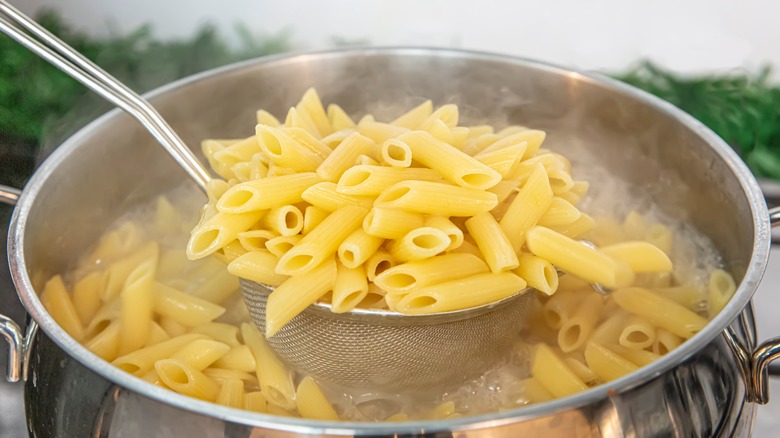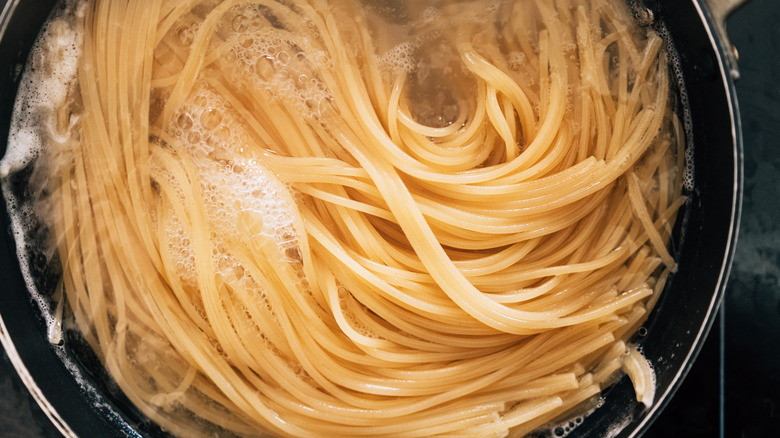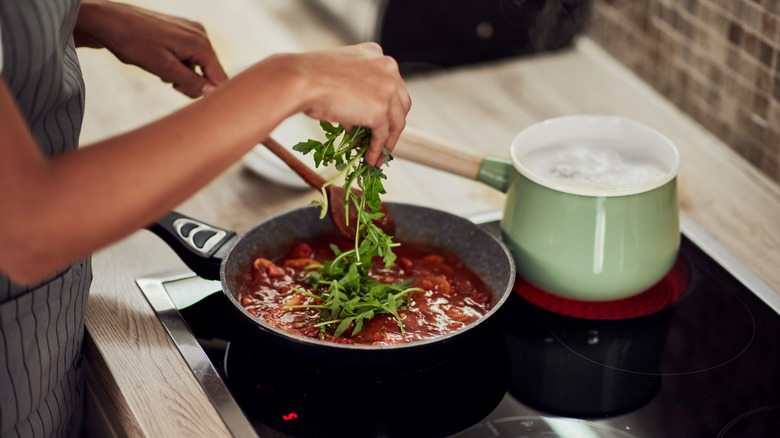Is It Really Necessary To Stir Pasta As It Cooks?
On the surface, pasta looks like a remarkably easy food to cook. All you do is basically boil water and cook your noodles until the desired doneness. What's so hard about that? But for many chefs, pasta isn't just something you toss into boiling water and forget about. There are certain rules and traditions one should follow when using any of the wide variety of pastas on the market.
For example, if you're making spaghetti, it's usually looked down upon to break the noodles before putting them in the water, according to chef Carolina Garofani (via Slate). The reason for this is that spaghetti is meant to be eaten twirled around a fork, something that is impossible to do when the noodles are in tiny pieces. If you're planning on making a pasta dinner, Martha Stewart recommends always taking the time to properly salt your pasta water, as this will help ensure that your pasta comes out flavorful rather than bland and tasteless. There is quite a laundry list of unspoken, but important, rules that one must follow when preparing pasta, be it a simple bowl of macaroni and cheese or a complex Italian dinner.
Another example of an unspoken rule is how often you should stir your pasta as it cooks. Is it really necessary to keep watch over that boiling pot of linguini while it softens, or does all of that stirring have unintended side effects?
Stirring your pasta is highly recommended
Imagine taking a bunch of soaking wet noodles and rolling them up into a single large mound. Let this mound of pasta rest for a little bit and then try it out. Chances are that it would taste like eating a flavorless sticky lump, and it's exactly what could happen if you don't stir your pasta frequently.
According to Smithsonian Magazine, stirring pasta helps to prevent your noodles from sticking to either the pot or together. As these noodles stick together, they "clump" and don't cook evenly throughout, leading to you chewing on a bundle of soft, perfectly done noodles that are stuck to harder, undercooked ones. But why does pasta stick together anyway, and how does stirring help to prevent it?
As Insider explains, in those first few minutes of the boiling process, your pasta is going to be covered in a very thick layer of starch. If you were to dump your noodles into the water and just leave them as is, the starch helps to bind the noodles together. If you've ever had French fries that get stuck together, it's actually very similar (via Idaho Potato). Starches in pasta and potatoes act as a "glue," holding everything together. It's only when you stir your pasta that the starches never get the chance to bind together.
But let's say you don't want to spend all that time hovering over your stove watching and stirring your pasta. How often should you stir it?
Stir your pasta in intervals
Now, obviously, no one wants to serve up a big plate of lumpy pasta for dinner. At the same time, you wouldn't want to tucker yourself out stirring your pasta in an endless frenzy. Fortunately, you don't need to wear your arm out constantly stirring. The trick to perfectly textured paccheri and other kinds of pasta shapes isn't how long you should be stirring, but when you should be doing so.
DeLallo's advice is that you should stir the pasta within the first 2 minutes of the cooking time, making sure to stir enough so that the starches never get the chance to clump together. Kitchn goes into a little more detail, noting that should you stir the pasta for one minute after adding it to the water and then another minute after. From there, the pasta will cook on its own without the danger of clumping together or sinking directly to the bottom. It also doesn't hurt to give the pasta a few extra stirs every now and then before you finish cooking, making sure that no renegade noodles have tried to clump or stick to the sides of the pot.


